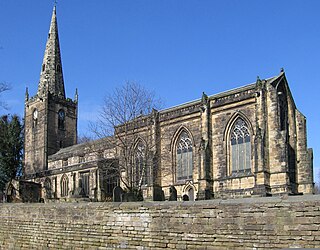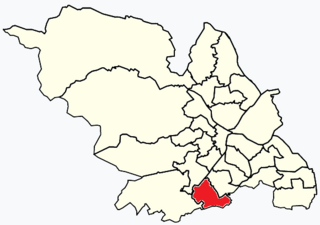
Dronfield is a town in North East Derbyshire, England, which includes Dronfield Woodhouse and Coal Aston. It lies in the valley of the River Drone between Chesterfield and Sheffield. The Peak District National Park is three miles (4.8 km) to the west. The name comes from the Old English Dranfleld, probably meaning an open land infested with drone bees.

King George V School is a coeducational international secondary independent school of the English Schools Foundation (ESF), located in Ho Man Tin, Hong Kong. The school has more than 1,900 students and is one of the oldest schools in Hong Kong. Students take IGCSEs/GCSEs followed by the International Baccalaureate Diploma or the British BTEC programme. There is a Learning Enhancement Centre (LEC) for students with learning difficulties. The campus has an area of 10.2 acres (4.1 ha). The school is one of three ESF secondary schools in Kowloon and the New Territories, the others being Sha Tin College and Renaissance College.

Dronfield Woodhouse is a district of Dronfield, in North East Derbyshire, England. The area has been inhabited since at least the 11th century and its main road, Carr Lane, features a 13th-century house, formerly Hall Farm. The 19th-century former primary school on Holmesfield Road is now an elderly care home.

Dinnington High School is a coeducational comprehensive school in Dinnington, in the Metropolitan Borough of Rotherham, South Yorkshire, England. With origins dating back to 1743, Dinnington High School is the oldest secondary school in the Metropolitan Borough, and the second oldest in South Yorkshire. It was one of the first comprehensive schools to be established in the United Kingdom and is notable for being one of the only schools in the world to have buildings designed by famous architect Sir Basil Spence. Former pupils of Dinnington High School are Old Dinnonians.

Holmes Chapel Comprehensive School is a co-educational secondary school and sixth form centre located in Holmes Chapel, Cheshire, England. It was founded in 1978 as a purpose-built 11–18 comprehensive and sixth form. It was opened in September 1978.

Gosforth Academy is an English secondary school in Gosforth, Newcastle upon Tyne. As well as having a sixth form department it is a specialist Language College. Many of its mainstream students come from three large feeder middle schools: Gosforth Central Middle School, Gosforth East Middle School and Gosforth Junior High Academy.

Morecambe Bay Academy is a coeducational secondary school and sixth form located in Morecambe, Lancashire, England. It was founded as Morecambe Grammar School in 1919, moving to its current site on Dallam Avenue in 1938 on a former golf links course. In 2019, it was renamed to Morecambe Bay Academy during the process of becoming an academy.

Sponne School in Towcester, Northamptonshire, England, is the oldest secondary school in Northamptonshire, and one of the oldest in the country. Part of the school was originally Towcester Grammar School, until Grammar schools were abolished in Northamptonshire. In 1968, the Grammar school was joined with the next-door Secondary Modern school, and the school was renamed Sponne, after Archdeacon William Sponne, who was Rector at the nearby St. Lawrence Church in the 15th century and the original founder of the school.
Witchford Village College is a secondary school in the village of Witchford, near Ely, Cambridgeshire, England. Before becoming an academy the school was a specialist Sports College. With approximately 820 pupils on roll, the college has fewer pupils than the national average (~950).
Arnold Hill Spencer Academy is a mixed secondary school and sixth form located in the county of Nottinghamshire in the East Midlands. It teaches children from 11 to 18 - Years 7-13. It is located in Arnold but it serves children from various nearby areas including Killisick, Daybrook, Woodthorpe, Mapperley, Carlton, Sherwood. It is split into 4 buildings ("A-Block", "B-Block", "6th Form Centre", and "Ramsey House" and has around 1600 pupils and over 100 teachers.
Halls of residence at the University of Bristol are generally located within three distinct areas of Bristol, the City Centre, Clifton and Stoke Bishop.
Ricards Lodge High School is a single-sex comprehensive secondary school for girls aged 11 to 16, located on Lake Road in Wimbledon, London. The school's headteacher has been Kate Page since 2022. It was judged as an Outstanding school by Ofsted in November 2017.
The Angmering School is a coeducational community secondary school and sixth form located in Angmering, West Sussex that opened in 1975. The school has Specialist Sports and Science College status. The headteacher is Simon Liley. There are approximately 1400 children on roll, with an age range of 11 to 18 years. There is a Sixth Form college on the site which offers an array of Level 3 qualifications.

Outwood Academy Hasland Hall is a co-educational secondary school situated in Hasland, a village in Chesterfield, Derbyshire, England.

North Leamington School (NLS) is a mixed, non-selective, comprehensive school for students aged 11 to 18 years located at the northeastern edge of Leamington Spa, Warwickshire, England. It is rated as a good school by Ofsted, and has 6.7% of children eligible for free school meals. Mike Lowdell is the current headteacher.
Teign School is an 11–18 academy school located in Kingsteignton, a town to the north of Newton Abbot. The original 1936 building has been expanded upon substantially and numerous additional buildings have been constructed within the grounds. The school has entry level at Year 7. The school also has a sixth form centre. In 2004 it was awarded specialist Science status by the Specialist Schools Trust. The most recent Ofsted inspection was on 16 April 2015 which resulted in a 'good' rating.

Thomas Fanshawe (1533–1601) was a Member of the English Parliament during the reign of Queen Elizabeth I. He also held the civil service post of Queen's remembrancer of the exchequer.

St John the Baptist’s Church, Dronfield is a Grade I listed parish church in the Church of England in Dronfield, Derbyshire.













